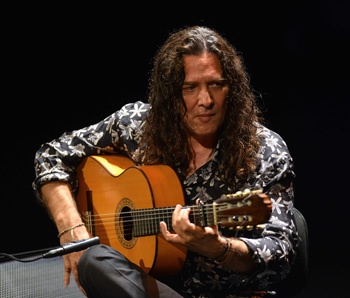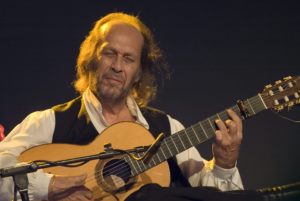Mastering Flamenco Guitar: Unleash Your Rhythmic Passion
Ignite your musical journey with Flamenco guitar and unlock the captivating styles of Solea, Bulerias, Alegrias, Fandango, Guajiras, Tangos, and Siguiriya, mastering harmonic structures and melodies in just 10 lessons per level—enroll now and unleash your passionate melodies to mesmerize the world!
Unveiling the Art of Solo and Accompaniment
Teaching Flamenco guitar in three levels, where students will learn the styles of Solea, Bulerias, Alegrias, Fandango, Guajiras, Tangos, and Siguiriya, along with the characteristic harmonic structures, melodies, and variations necessary to make the songs flow, enabling them to master each style as solo instruments or creating accompaniments, with each level consisting of 10 lessons.
Flamenco Guitar Mastery: Unleash Your Expression
This flamenco guitar course will unlock new dimensions of your musical expression by helping you understand the flamenco sound and integrating it seamlessly into your playing.
Prices Flamenco Guitar Lessons
Please note that flamenco guitar courses have different pricing from the generic price structure. However, all other conditions remain unchanged.
- Private Lessons: $95 per hour
- 10-Week Course (10 hours private): $635 per level
Requirements
To effectively achieve the course objectives, students must possess a practical understanding of scales, chords, and harmony. All students are required to pass an entrance exam or have completed level 3 in the Creative Guitar School general program. For more information, please email me.
What are you waiting for?
Call me for a Free Assessment !
The flamenco sound is characterized by a major key with a modal quality. It’s crucial for the guitarist to consistently emphasize the flamenco mode to the listener. If the mode isn’t consistently highlighted, our perception can easily shift to a more standard Ionian sound, commonly found in pop music.
Contrast between major and minor
One of the key elements of the flamenco sound lies in the contrast between major and minor chords. When in the relative key of C, the tonal center shifts to E in flamenco. Instead of using the typical diatonic minor chord as the tonal center, it is altered to sound major, resulting in E7 becoming the focal point for all cadences. This distinctive resolution to E7 creates the contrasting and recognizable flamenco sound.
To truly understand and embrace the flamenco sound, it’s essential to memorize a series of 12-bar phrases that serve as the foundation of the flamenco style, building a rich vocabulary of musical expressions.
Flamenco = Modal music
Flamenco music can be considered modal, meaning it is based on specific musical modes or scales. As musicians, we approach chords differently in modal music, viewing them not as consecutive thirds but as clusters of notes that create varying degrees of tension when moving towards or away from the home chord. This approach allows us to maintain the authentic flamenco environment and avoid our perception drifting towards the more standard major sound.
In flamenco guitar lessons, we learn to use chordal vertical structures and harmonic movements carefully to preserve the essence of the flamenco sound and keep the listener connected to the modal experience, avoiding any shifts towards the relative major. By mastering these techniques, we can fully embrace and express the captivating beauty of flamenco music.
Let’s assume we are in the key of E, with the tonal center defined by E7 and all available tensions and chords belonging to the relative C scale.
To get familiar with the flamenco sound, begin by playing the tonic on the Spanish guitar without the third, adding passing tones such as tensions 7, b9, #5, and sus4. Keep these tones brief and resolve quickly to the corresponding note of the major tonic with the third.
Now, for a beat or two, move to a subdominant sound that creates contrast using the following root notes:
- b11 b
- V11m
- and V diminished
Experiment with them on weak beats and ensure they have short durations. Avoid playing only block chords; try arpeggiating them for further contrast with the tonic sound.
Melodic Flamenco Passing Tones
As you delve into melodic flamenco passing tones, explore the following tensions:
- bII: Tensions b7, 7, b5, #11, 9, b9, 13
- bV11m: Tensions 7, b5, 9, 11, 13
- V diminished: Tensions 7, 9, 11, #11
Create Your own Chords
Additionally, experiment with vertical structures that have a lesser degree of tension compared to the previous chords. Note that the following chordal structures share some similar notes with the tonic chord:
- IVm: Tensions 7, 9, sus4, 6, 9, 11, 13
- VI: Tensions 7, Maj7, #5, 9, 11, 13
- III: Tensions 7, 9, sus4, #5, 6, 11, #11, 13
Try creating melodic ideas by arpeggiating them and resolving either on the tonic chord or on the following:
- b11
- bV11m
- and V diminished
Flamenco Styles
Flamenco encompasses over 100 different styles classified by time signature, geographical origin, folk music origin and the structure of the lyrics.

Here is a list of 35 common styles classified in alphabetical order:
- Rondeña
- Rumba
- Saeta
- Seguiriya o Siguiriya
- Serranas
- Sevillana
- Soleá
- Tango
- Tanguillo
- Taranta o Taranto
- Tientos
- Toná
- Trillera
- Verdiales
- Vidalita
- Zambra
Additional Resources for Flamenco
Discover flamenco music on my YouTube channel! Enjoy a curated playlist of diverse artists showcasing flamenco styles. Subscribe now to experience the enchanting sounds and be transported to Spain’s vibrant landscapes
Additional Resources for Flamenco
Discover flamenco music on my YouTube channel! Enjoy a curated playlist of diverse artists showcasing Flamenco Guitar Style. Subscribe now to experience the enchanting sounds and be transported to Spain’s vibrant landscapes!

